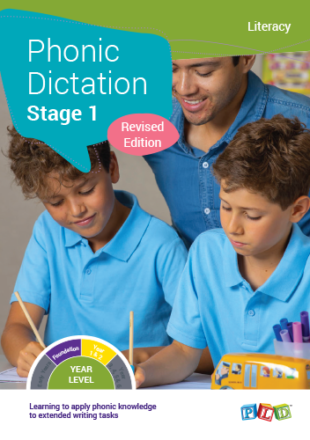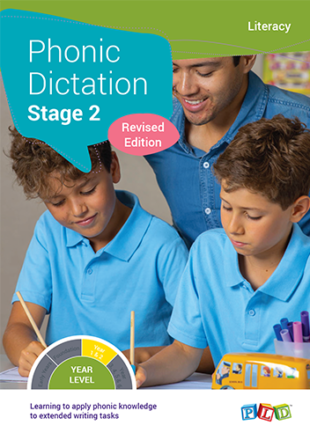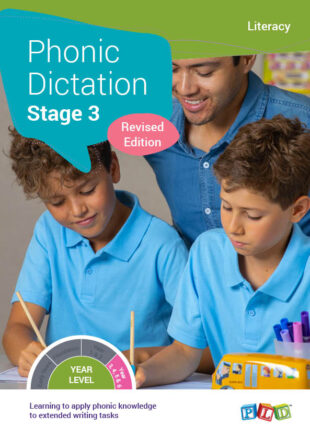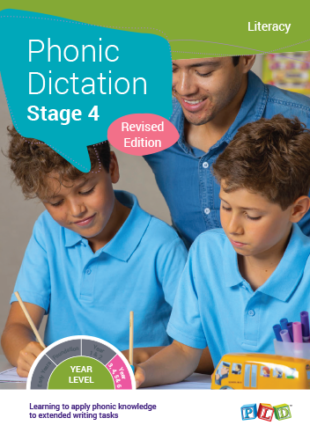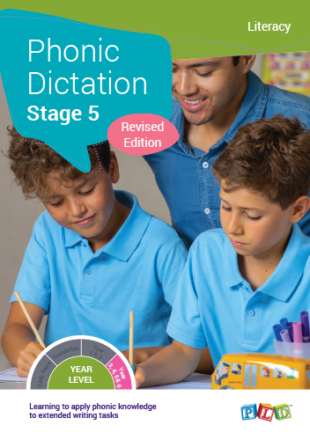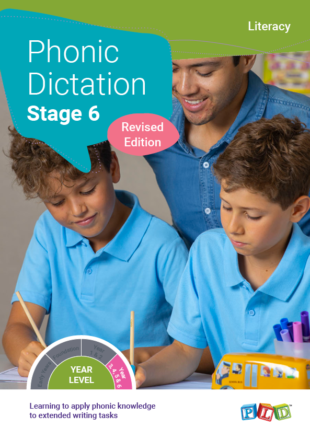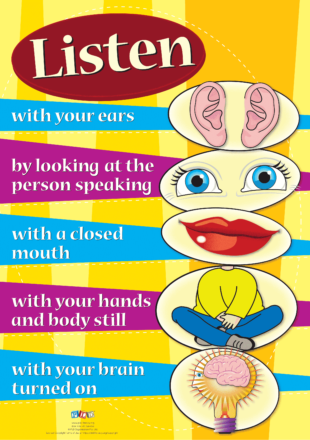Students often write words correctly in spelling tests but struggle when applying their new knowledge to written work. Why? As a general rule, when transferring spelling into writing, students require the activation of many more skills. Explained simply, single word spelling is quite a simple cognitive task in comparison to extended writing tasks.
PLD dictation tasks encourage the development of strong listening and auditory memory skills which are important for learning and literacy. Dictation is seen by many in education as old fashioned, but dictation is a powerful, time-efficient and often underutilised instructional medium. As part of a Structured Synthetic Phonics (SSP) program, phonic dictation has the potential to provide students with repeated practice with this more challenging task. How? As students complete dictation tasks, they are faced with the challenge of applying their recently acquired spelling concepts to the rewriting of passages. The presentation of regular phonic dictation sessions enables students to continually focus on this specific area.
What are the benefits of dictation?
- PLD Dictation develops attention, focus and listening skills. Noisy and distractible students will be required to become attentive very quickly.
- PLD Dictation is easier than self-generated writing as you are supplying the writer with the content.
- The way you present the dictation passages can provide your students with opportunities to rehearse specific aspects of writing.
- Listening skills such as not asking for words to be repeated, maintaining focus, listening to increasing large sections of text (i.e. from 3 words to full sentences/8 words) are honed.
- Well-chosen passages will expose students to good literature and will help them to reproduce well constructed grammatically correct sentences with correct punctuation.
- Phonic focus, thereby facilitating the transference of spelling concepts into written work. Sounding out difficult words and attempting words phonetically when the spelling is not known.
- In our experience at PLD, repeated reading does not appeal to many students. A typically encountered comment being “I have already read that book!.” PLD’s Phonic Dictation series aims to counteract this by adding a timed aspect to the readings. In our experience, we have found that it is motivating for students to observe that their re-readings become more accurate and fluent. Read the entire blog HERE.
- The below PLD Phonic Dictation resources are suitable for Year 1 to 6. However, you can begin dictation tasks as early as the Foundation Year through First Writing Activities.
PLD’s 13 top tips for teaching dictation
TIP 1: Initially teach your students how to engage in a dictation task.
Within the ‘introduction to dictation’ phase, the selection of general passages or simplistic passages are appropriate. Classes who have not been exposed to dictation before, need to understand what is expected in the presentation of dictation tasks.
TIP 2: Crowd control is essential!
Dictation requires students’ attention. Teachers will need to impose ‘crowd control’ measures in their classes and remind students what constitutes ‘good’ listening behaviour. Over time, teachers may choose not to repeat the section of the passage read, when inattentive students as “Oh, can you repeat it once again?” Download PLD’s Listening Poster.
TIP 3: Read the passage before students begin dictation.
Before students commence a dictation task, it is recommended they are exposed to the passage beforehand. It is extremely beneficial if students are able to process the meaning of the passage or sentence before writing out its parts. Before students pick up their pencils, PLD recommends that either the teacher or the group of the students read the whole passage.
TIP 4: Do not let students write while you are speaking.
Dictation tasks must be presented in chunks, not word by word, as chunks of texts maximise the benefit for students in terms of their listening and auditory memory skills. This practice helps with the transference of spelling skills into extended writing. We recommend that teachers repeat the phrase (or 3-8 words depending on the age of the student) 3-5 times and then ask the students to pick up their pencils and start writing. This encourages the students to listen carefully and utilise their memory skills as they transcribe extended writing rather than as single words.
TIP 5: For students with language or literacy delays, ask them to repeat words aloud before they write them.
A highly effective tip when working with students who have dyslexia, students whom English is not a first language or those who have oral language difficulties, is to ask the students to repeat the words back to you before they write them. This will help them to focus on the words and consider the sounds in the words as they write. For these students, dictation should be presented in short sessions (possibly only a few words) with lots of repetition.
TIP 6: Include dictation as part of your spelling program.
Dictation can be seen as old fashioned and traditional, however, it is highly recommended as part of a Structured Synthetic Phonics (SSP) approach to spelling. Dictation tasks have value when integrated with SSP as they facilitate the transference of phonic concepts into extended writing. Learning to spell in context is the ultimate goal, and dictation directly practices this important process. An additional benefit of dictation tasks is the opportunity to practice correct sentence structure and punctuation.
TIP 7: Use dictation sentences that include multiple examples of the focus spelling pattern.
When used as part of a SSP spelling program, dictation passages ideally should include words and phonic concepts that have or are being taught. The passages need to have multiple examples of words from spelling lists or other words that include the same phonic pattern. Additionally, sentences should also include high frequency words and age-appropriate vocabulary. As students complete the PLD Dictation tasks, they are provided with the challenge of applying their recently acquired spelling concepts to the rewriting of passages. This allows students to rehearse transferring spelling concepts to their writing. See PLD’s Phonic Dictation Resources for passages suitable for dictation based on specific phonic concepts.
TIP 8: Include short regular sessions of dictation.
Consider running short, regular dictation sessions. Aim for 5, 10, or 15 minute sessions each week. Including short regular sessions allows students to practice and develop proficiency with the task. For a general overview on when to schedule dictation tasks download our Whole School Literacy Plan. The dictation tasks are detailed on pages 18 and 22.
TIP 9: Repeat the same passage.
Consider repeating the same passage rather than always presenting a new passage. This works particularly well if you are including several dictation sessions in a week and focusing on one spelling list for a week. Repetition of the same passage allows students to consolidate what they learn and compare their progress across the repeated dictation exercises.
TIP 10: For struggling students and students with delays, consider using the dictation passage as a repeated reading exercise before presenting it as a dictation task.
Exposing students to the passage in a repeated reading task allows them to become familiar with the phonic concepts, words, sentence structures and content. When the task is presented as a dictation task, it is already familiar and therefore a less daunting task.
TIP 11: Consider the length of the section verbalised and the number of times it will be repeated.
Consider carefully the length of each section verbalised and the number of times the section is repeated before (or while) the students transcribe. The shorter the section, the less challenging the dictation task. Repetition of the dictated sections will reduce the memory requirement and make the task less challenging. It is recommended that, over time, the length of each section is gradually extended and the amount of repetition is gradually reduced. This helps students apply greater levels of auditory processing and memory.
TIP 12: Encourage students to edit their work.
Once the dictation task has occurred, read the passage from beginning to end and ask students to edit their work. Students can then be asked to mark their work, or a partner, based on a provided rubric, or a list of key elements provided by the teacher. Allowing students to identify and correct any of their errors they may have made further consolidates learning. For example, correct punctuation and capitalisation, correct spelling of target spelling words, correct spelling of select high frequency words, neatness of handwriting etc. For teachers, marking dictation tasks is often not very appealing. An option for the first presentation of the passage is, the student edits and then second the teacher marks.
Tip 13: Phonic dictation can function as ongoing revision of concepts covered
Commonly teachers aim to align the selected phonic based dictation passages with the phonic list words of the week. While this is an option, dictation can also function as revision, by presenting last week’s or last month’s phonic concepts within the dictation passages.
Remember, many students express that they greatly enjoy dictation writing. This structured (non-creative) form of writing, to rehearse their spelling, punctuation, sentence construction and writing with increased efficiency. Over time these skills will flow through to creative and/or curriculum writing.
If you would like to know more about how dictation can help your students transfer their spelling words into writing, then PLD has created this short course on the benefits of the regular presentation of PLD dictation. The course presents many options and caters for a wide range of ability within various primary school settings. Find out more HERE.
We hope you enjoyed this blog. At PLD we are always available to help you achieve the best possible literacy outcomes for your students. If you have any questions about Phonic Dictation or anything else we do here at PLD get in touch with us through our chat icon in the bottom right of the screen or to mail@pld-literacy.org.



 print
print